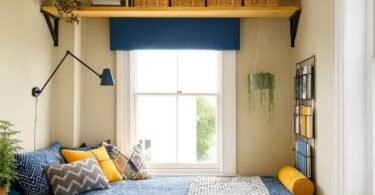Creating Your Child’s Perfect Space Without Breaking the Bank
We all know that feeling when we walk into our child’s room and realize it looks more like a tornado hit a toy store than a peaceful sanctuary. Trust me, I’ve been there. The good news? You don’t need to spend your kid’s college fund to create a bedroom that’s both functional and magical.
Your child’s bedroom serves as their personal headquarters, creative studio, and peaceful retreat all rolled into one compact space. This room shapes memories that’ll stick with them long after they’ve outgrown their dinosaur phase or princess obsession. That’s why getting it right matters so much, even when you’re working with a tight budget.
The secret lies in smart planning, creative thinking, and knowing where to splurge versus where to save. We’re talking about transforming a basic room into something special without requiring a second mortgage. Ready to dive in? Let’s explore how to create a bedroom your child will love that won’t leave your wallet crying.
Understanding Children’s Room Decor Themes
Finding the Right Theme That Grows With Your Child
Picking a theme for your kid’s room can feel overwhelming. Walk down any toy aisle, and you’ll see hundreds of character options screaming for attention. But here’s what I’ve learned after watching too many parents redecorate every six months when their child moved from trucks to dinosaurs to superheroes.
The smartest approach involves choosing themes with staying power. Think broader concepts rather than specific characters. A “space adventure” theme works better than “Star Wars Episode VII” because it can evolve. Your five-year-old might love rockets and planets, and your ten-year-old can still appreciate astronomy and science fiction elements.
Nature themes offer incredible flexibility and budget-friendly options. Forest animals, underwater worlds, or garden themes provide endless DIY possibilities. You can create tree wall decals from brown construction paper, paint simple flowers on walls, or hang paper butterflies from the ceiling. These elements cost pennies compared to licensed character merchandise.

Creating Comfort Through Smart Material Choices
The foundation of any great kids’ room starts with flooring decisions. Hardwood floors look beautiful and last forever, but they’re not always budget-friendly for every family. Laminate flooring gives you that wood look without the premium price tag. The key lies in choosing options that can handle the beating kids dish out daily.
Area rugs become your secret weapon for both comfort and style. A large, colorful rug defines the play area and provides cushioning for those inevitable tumbles. Look for machine-washable options because spills happen. That grape juice incident? It’s coming, and you’ll thank yourself for thinking ahead.
When it comes to wall treatments, paint remains your most cost-effective option. A gallon of quality paint can transform an entire room for under fifty dollars. Choose washable paint finishes because little hands love leaving fingerprints on walls. Semi-gloss or satin finishes wipe clean easily while still looking great.
Balancing Safety With Style
Safety doesn’t mean sacrificing style, but it does mean thinking differently about design choices. Sharp corners on furniture become safety hazards when kids are running around playing tag. Rounded corners or corner guards solve this problem without breaking your design vision.
Window treatments need extra consideration in children’s rooms. Long curtains create strangulation hazards, while cordless blinds offer safety with style. If you love the look of curtains, choose shorter lengths that stop at the windowsill. Blackout options help with naptime and early bedtimes.
Storage solutions that double as safety features make smart budget choices. Toy chests with soft-close hinges prevent finger pinching. Low, open shelving keeps books and toys accessible while eliminating climbing temptations. Every storage piece should serve multiple purposes to maximize your investment.
Comfortable Nursery Decor and Furniture Ideas
Maximizing Comfort on a Minimal Budget
Creating a comfortable space doesn’t require expensive furniture or designer accessories. Comfort comes from thoughtful planning and understanding how children actually use their rooms. Kids need spaces that feel cozy without feeling cramped, organized without being sterile.
Seating areas make huge differences in room comfort. A simple bean bag chair costs a fraction of upholstered furniture but provides the same cozy reading nook appeal. Floor cushions offer flexible seating that works for quiet time, game playing, or movie watching. You can even make your own using fabric remnants and stuffing.
Lighting plays a major role in comfort levels. Overhead lighting alone creates harsh shadows and unfriendly spaces. Table lamps, string lights, or wall sconces add warmth and visual interest. Battery-operated LED string lights eliminate electrical concerns while adding magical ambiance that kids love.
Temperature control affects comfort more than most parents realize. Ceiling fans help circulate air and can often substitute for expensive air conditioning. In colder climates, adding a small space heater with safety features keeps kids cozy during chilly nights. Proper window coverings help regulate room temperature naturally.
Smart Furniture Choices That Grow With Kids
The biggest mistake parents make involves buying furniture their children will outgrow quickly. A toddler bed might seem perfect for your three-year-old, but a twin bed with guardrails serves the same purpose and lasts much longer. Think about purchases in terms of cost per year of use rather than upfront expense.
Multi-functional furniture pieces stretch your budget further. Storage ottomans provide seating and toy storage. Desk chairs that adjust height accommodate growing children. Bookshelves that work as room dividers serve double duty in shared bedrooms. Every piece should earn its place through multiple functions.
DIY furniture projects can save significant money while creating custom solutions. Simple wooden crates become instant storage cubes or nightstands. Old dressers get new life with fresh paint and fun drawer pulls. Building basic shelving costs less than buying finished pieces and fits your exact space requirements.
Used furniture shopping opens up possibilities that new furniture budgets can’t touch. Thrift stores, online marketplaces, and garage sales offer quality pieces at fraction prices. A good coat of paint transforms tired furniture into fresh focal points. Just check for recalls and safety issues before bringing anything home.
Creating Organization Systems That Actually Work
Organization systems fail when they’re too complicated for kids to maintain. Simple solutions work better than elaborate setups. Clear plastic bins let kids see contents without opening every container. Labels with pictures help non-readers identify where things belong. Easy access encourages cleanup participation.
Vertical storage maximizes small room space. Wall-mounted cubbies keep floors clear while providing plenty of storage. Over-door organizers utilize otherwise wasted space. Hooks at kid height encourage jacket and backpack hanging. Think up rather than out when space is limited.
Rotation systems keep toy collections manageable. Store half the toys and rotate them monthly. This approach makes old toys feel new again while reducing clutter. Kids appreciate having fewer choices and parents appreciate less mess. Win-win situations make budget decorating easier.
Clean-up time becomes less overwhelming with designated homes for everything. Toy categories get specific storage spots. Art supplies live in one drawer. Dress-up clothes hang in one section. When everything has a place, maintaining order becomes possible even for busy families.
Mastering Color Schemes and Lighting
Understanding Color Psychology in Children’s Spaces
Colors affect mood and behavior more than most people realize. Bright red might seem fun, but it can actually increase hyperactivity and make bedtime struggles worse. Understanding basic color psychology helps you make choices that support both fun and functionality in your child’s room.
Blue tones promote calmness and better sleep patterns. Light blues work well for main wall colors, while deeper blues can accent bedding or accessories. Green shades offer similar calming effects while connecting to nature themes. These colors create peaceful environments that support rest and relaxation.
Warm colors like yellow and orange add energy and creativity to spaces. Use these shades in play areas or as accent colors rather than dominant wall colors. Too much warm color can overstimulate children and interfere with sleep. Balance becomes the key to successful color schemes.
Neutral base colors provide flexibility as children’s preferences change. Beige, soft gray, or cream walls work with any theme or color scheme. You can add personality through bedding, artwork, and accessories that cost less to change than repainting entire rooms. This approach saves money long-term.
Creating Lighting That Works Day and Night
Natural light should be your starting point for any room design. Maximize daylight with light-colored walls and mirrors that reflect sunshine around the room. Sheer curtains provide privacy while still allowing sunlight to filter through. Natural light improves mood and helps regulate sleep cycles.
Task lighting makes homework and reading time more pleasant. Desk lamps with adjustable arms direct light exactly where it’s needed. Reading nooks benefit from dedicated lamps that eliminate eye strain. Good task lighting prevents squinting and headaches during focused activities.
Ambient lighting creates the cozy atmosphere that makes bedrooms feel welcoming. String lights around windows or doorways add magical sparkle. Night lights provide comfort for children afraid of the dark. Dimmer switches let you adjust lighting levels for different activities and times of day.
Safety considerations become paramount with children’s lighting choices. Lamps should have stable bases that won’t tip easily. Electrical cords need to be tucked away from play areas. Battery-operated options eliminate electrical hazards while still providing needed illumination. Always prioritize safety over aesthetics.
Combining Colors and Light for Maximum Impact
The relationship between color and light determines how your room actually looks and feels. Dark colors absorb light and make rooms feel smaller. Light colors reflect illumination and create spacious feelings. Plan your color scheme around your available natural light levels.
Rooms with limited natural light benefit from lighter, brighter color schemes. White or cream walls reflect available light and prevent cave-like feelings. If you want darker accent colors, use them sparingly in areas that receive direct light. Balance dark and light elements throughout the space.
Artificial lighting can enhance or detract from your chosen colors. Warm light bulbs make reds and yellows pop while cooling blue and green tones. Cool light enhances blues and greens but can make warm colors look muddy. Test your color choices under your actual lighting conditions before committing.
Seasonal lighting changes can refresh rooms without major redecorating. Summer might call for brighter, cooler lighting while winter benefits from warmer, cozier illumination. String lights can change from white to colored bulbs. Lamp shades can be swapped seasonally for different effects.
Creating Atmosphere Through Design Elements
Building Emotional Connection to Space
Children need to feel ownership over their personal spaces. This emotional connection makes them more likely to care for their room and feel comfortable in their environment. Creating this connection doesn’t require expensive purchases, just thoughtful planning and child involvement.
Display areas for your child’s artwork and achievements build pride and personalization. Create a rotating gallery wall using clipboards or picture frames. Let your child choose which pieces to display and change them regularly. This approach costs almost nothing but means everything to a child’s self-esteem.
Personal collections deserve special showcasing. Whether it’s rocks, action figures, or stuffed animals, creating dedicated display spaces shows you value what your child loves. Simple shelving or shadow boxes work perfectly for this purpose. The investment in display space pays dividends in child happiness.
Memory walls capture growing-up moments and special experiences. Photo collages, ticket stubs from family outings, or certificates from school activities create visual stories of your child’s life. These personal touches make rooms feel special and connected to family history.
Incorporating Texture for Sensory Interest
Texture adds dimension and interest to rooms without requiring major budget commitments. Different fabrics, materials, and surfaces create visual and tactile variety that keeps spaces from feeling flat or boring. Kids especially benefit from textural variety because they explore their world through touch.
Soft textures provide comfort and coziness. Plush area rugs invite floor play and provide warmth. Throw pillows and blankets add color while creating snuggle spots. Fabric wall hangings or tapestries introduce textile interest without permanent installation requirements.
Natural textures connect children to the outdoors and provide sensory richness. Woven baskets for storage add warmth and organic appeal. Wooden elements bring natural beauty and durability. Stone or shell collections displayed in clear containers create textural focal points.
Contrasting textures create visual interest and design sophistication. Smooth surfaces paired with rough ones, or soft fabrics combined with hard materials, create dynamic combinations that hold attention. This design principle works even with budget-friendly materials and DIY projects.
Balancing Stimulation with Calm
Children’s rooms walk a fine line between providing enough stimulation for creativity and learning while maintaining calm spaces for rest and relaxation. Getting this balance right affects your child’s ability to both play actively and sleep peacefully in their space.
Active play areas benefit from brighter colors, interesting textures, and engaging displays. This might be where you place art supplies, building toys, or dress-up clothes. The goal is creating excitement and encouraging imagination without overwhelming the senses.
Quiet zones need calmer influences. Soft colors, comfortable seating, and gentle lighting create spaces conducive to reading, puzzles, or just thinking. Every child’s room should include at least one spot designed specifically for winding down.
The transition between active and calm areas can be subtle but effective. Color gradients, lighting changes, or different flooring materials can signal function shifts without requiring walls or physical barriers. Open floor plans work well when zones are clearly defined through design elements.
Storage solutions support both active and calm functions. Quick cleanup systems encourage active play by reducing post-play work. Organized spaces promote calm feelings and reduce stress. The way you handle storage directly impacts both energy levels and emotional responses to the space.
Natural Materials and Sustainable Choices
Why Natural Materials Matter for Growing Children
Children’s developing systems are more sensitive to environmental factors than adult bodies. Natural materials typically contain fewer harmful chemicals and off-gas less volatile organic compounds (VOCs) than synthetic alternatives. This makes them better choices for spaces where children spend significant time.
Wood furniture and accessories bring warmth and natural beauty to children’s rooms. Solid wood pieces last longer than particle board alternatives and can be refinished rather than replaced as children grow. Used solid wood furniture often costs less than new particle board pieces while offering superior durability and safety.
Natural fiber textiles feel better against skin and breathe better than synthetic materials. Cotton, wool, and linen bedding help regulate body temperature during sleep. These materials also tend to be more durable and maintain their appearance longer than synthetic blends, making them better long-term investments.
Organic and low-VOC paints and finishes protect indoor air quality while still providing the colors and protection you need. Many major paint manufacturers now offer eco-friendly lines that perform just as well as traditional formulations. The small price premium pays off in health benefits and peace of mind.
Budget-Friendly Ways to Incorporate Natural Elements
Bringing nature indoors doesn’t require expensive purchases or major renovations. Simple additions can transform sterile spaces into environments that feel connected to the natural world. Many of these additions cost little but provide significant impact on room atmosphere.
Plants suitable for children’s rooms improve air quality while teaching responsibility. Spider plants, pothos, and snake plants tolerate neglect and low light conditions. Your child can participate in watering and care, learning valuable lessons about nurturing living things. Plants also add color and life to any decorating scheme.
Natural collections make beautiful and educational decorations. Beach glass, interesting rocks, pinecones, or shells displayed in clear containers create focal points that spark curiosity and conversation. Seasonal nature walks can provide ongoing additions to these collections at no cost.
Wood elements add warmth without major expense. Driftwood pieces become unique wall art or bookends. Small tree branches can hold jewelry or accessories. Wooden crates stack into storage systems or display areas. Natural wood’s organic shapes and grain patterns add visual interest to any room design.
Natural lighting maximizes your connection to outdoor rhythms. Arranging furniture to take advantage of natural light helps regulate circadian rhythms and improves mood. Mirrors strategically placed can bounce natural light to darker corners, reducing the need for artificial illumination during daytime hours.

Creating Healthy Indoor Environments
Indoor air quality directly affects children’s health, sleep quality, and cognitive development. Simple choices in materials and maintenance can create healthier environments without spending extra money. Prevention costs less than dealing with problems after they develop.
Dust reduction strategies improve breathing and reduce allergens. Hard flooring surfaces collect less dust than carpeting and clean more easily. Regular vacuuming with HEPA filters captures more allergens than standard filtration. Washable area rugs provide softness without permanent dust collection.
Chemical reduction starts with reading labels and choosing products with minimal artificial additives. Water-based finishes contain fewer VOCs than oil-based alternatives. Natural cleaning products work just as well as chemical cleaners for most purposes while being safer around children.
Ventilation improvements can be as simple as opening windows regularly or using fans to circulate air. Stagnant air accumulates pollutants and feels stuffy. Fresh air movement keeps spaces feeling clean and energized. Even small improvements in air circulation make noticeable differences in room comfort.
Moisture control prevents mold and mildew growth that can trigger respiratory problems. Proper ventilation in bathrooms and kitchens reduces humidity throughout the home. Dehumidifiers in damp climates or seasons maintain comfortable moisture levels. Address any leaks promptly to prevent ongoing moisture problems.
Organization and Space Planning Strategies
Maximizing Small Spaces Through Smart Design
Small bedrooms challenge creativity but can become incredibly functional with proper planning. The key lies in thinking three-dimensionally and making every square foot work harder. Vertical space often goes unused in children’s rooms, representing missed storage and display opportunities.
Loft beds create instant floor space underneath for play areas, desks, or additional storage. This approach essentially doubles your usable room area. Safety railings and sturdy construction are non-negotiable, but the space benefits make this investment worthwhile for many families.
Wall-mounted storage keeps floors clear while providing plenty of organization options. Floating shelves display books and collections while using minimal visual space. Wall pockets hold school supplies, small toys, or bedtime stories. Magnetic strips on walls can hold metal cars or building pieces.
Under-bed storage utilizes otherwise wasted space. Rolling drawers slide easily for access while keeping contents organized and dust-free. Storage boxes designed for under-bed use maximize height restrictions. This hidden storage works perfectly for seasonal clothing, extra bedding, or toys not currently in rotation.
Multi-level storage systems create maximum organization in minimum space. Tall, narrow bookcases fit in corners while providing extensive storage. Stackable cubbies adjust to changing needs. These systems grow with your child and adapt to different storage requirements over time.
Creating Functional Zones in Shared Bedrooms
Siblings sharing bedrooms need personal space and privacy even within shared environments. Creating distinct zones helps reduce conflicts while maximizing room functionality. Each child needs areas they can call their own along with shared spaces for joint activities.
Visual dividers create separation without permanent walls. Tall bookcases, curtains, or folding screens define personal areas while maintaining open feeling. These solutions cost less than construction while providing needed psychological boundaries. Children need space to retreat and feel ownership.
Individual storage systems prevent arguments over belongings. Each child gets designated closet sections, drawer space, and toy storage. Color-coding systems help younger children identify their belongings. Clear ownership boundaries reduce conflicts and teach organizational responsibility.
Shared zones work well for activities requiring cooperation or supervision. Play areas in room centers allow both children access while parents can supervise easily. Shared reading nooks with comfortable seating encourage quiet time together. These spaces build positive sibling relationships while serving practical functions.
Personal expression areas let each child showcase their interests and achievements. Individual bulletin boards, photo displays, or collection areas provide identity within shared space. This approach honors each child’s uniqueness while maintaining family unity and cooperation.
Developing Age-Appropriate Organization Systems
Organization systems must match children’s developmental abilities to be successful. Complex systems frustrate young children while simple systems bore older kids. Age-appropriate organization grows with children and teaches valuable life skills progressively.
Toddler organization relies on visual cues and simple sorting. Picture labels on storage containers help non-readers identify contents. Large, easy-to-handle containers prevent frustration. Open storage keeps contents visible and accessible. The goal is participation rather than perfection at this stage.
School-age children can handle more complex organization with categories and subcategories. Homework stations with designated supplies support academic success. Hobby areas with specialized storage encourage sustained interests. Children this age can maintain systems with occasional guidance and encouragement.
Teenage organization systems should support independence and personal style. Modular systems adapt to changing needs and interests. Privacy becomes more significant, with closed storage options preferred over open systems. Organization tools should look mature rather than childish.
Teaching organizational skills happens gradually through modeling and practice. Start with simple systems and build complexity over time. Celebrate success and problem-solve challenges together. The goal is building lifelong habits rather than perfect rooms at any specific moment.
Safety Considerations and Child Development
Creating Safe Environments That Support Growth
Safety in children’s bedrooms goes beyond obvious hazards to include supporting healthy development and reducing injury risks. A truly safe room considers both physical safety and emotional security, creating environments where children can explore and grow confidently.
Furniture stability prevents tip-over accidents that can cause serious injuries. Anchor tall furniture to walls using safety straps or brackets. Place heavy items on lower shelves to maintain low center of gravity. Test furniture stability regularly as children grow and use furniture differently.
Electrical safety requires ongoing attention as children develop climbing and exploration skills. Cover outlets with safety plugs or sliding covers. Secure loose cords behind furniture or use cord management systems. Consider tamper-resistant outlets in new construction or major renovations.
Window safety becomes critical as children gain mobility and curiosity. Install window stops that prevent openings large enough for children to fall through. Keep furniture away from windows to reduce climbing opportunities. Cordless window coverings eliminate strangulation hazards while providing privacy and light control.
Toy safety involves both initial selection and ongoing maintenance. Check age recommendations and avoid toys with small parts for younger children. Inspect toys regularly for damage that could create hazards. Establish systems for recalling or discarding broken toys promptly.
Supporting Healthy Sleep Patterns Through Design
Quality sleep directly affects children’s physical growth, emotional regulation, and cognitive development. Bedroom design can either support or interfere with healthy sleep patterns. Small changes in environment can significantly impact sleep quality and duration.
Temperature control helps maintain optimal sleep conditions. Cooler rooms generally promote better sleep, with ideal temperatures between 65-70 degrees Fahrenheit. Proper bedding that can be adjusted for seasons maintains comfort throughout the year. Fans provide air circulation and white noise that many children find soothing.
Light control signals the brain when to sleep and wake. Blackout curtains or shades help maintain darkness during sleep hours. Night lights provide security for children afraid of darkness without interfering with sleep quality. Gradual light changes can ease morning wake-up routines.
Noise management creates peaceful sleep environments. Soft materials like curtains, rugs, and upholstered furniture absorb sound. White noise machines or fans can mask household sounds that might wake children. Consider your home’s noise patterns when arranging bedroom furniture and selecting sound-absorbing materials.
Comfort factors affect sleep quality beyond just mattress selection. Proper pillow support changes as children grow. Bedding materials should feel comfortable against skin and regulate temperature appropriately. Personal comfort items like favorite stuffed animals provide emotional security that supports peaceful sleep.
Adapting Spaces for Changing Developmental Needs
Children’s needs change rapidly, and bedroom design should accommodate these changes without requiring complete overhauls. Flexible design approaches save money while ensuring rooms remain functional as children grow and develop new capabilities and interests.
Infant rooms focus on caregiver convenience and safety. Easy access for nighttime care, adequate lighting for feeding, and safe sleep environments take priority. Storage for diapers, clothing, and feeding supplies needs to be convenient but secure. The room serves parent needs as much as infant needs.
Toddler adaptations address newfound mobility and curiosity. Safety measures increase as climbing and exploration abilities develop. Storage systems must be more secure while remaining somewhat accessible. Play space becomes more significant as active play increases and nap requirements change.
School-age modifications support academic responsibilities and developing independence. Homework areas with proper lighting and organization become necessary. Storage needs shift toward school supplies, projects, and collections. Privacy needs increase as social awareness develops.
Teenage transitions require major philosophical shifts toward independence and personal expression. Privacy becomes paramount, and design should reflect developing identity. Storage systems should support more complex belongings and activities. The room becomes a retreat space more than a supervised play area.

Building Independence Through Environmental Design
Bedroom design can either support or hinder children’s developing independence. Thoughtful choices create environments that encourage self-sufficiency while maintaining appropriate safety measures. The goal is gradual skill building rather than premature independence.
Accessibility considerations help children manage their own needs. Clothing storage at appropriate heights allows independent dressing. Light switches within reach support bedtime routines. Step stools safely extend reach for older children while maintaining safety for younger siblings.
Organization systems that children can maintain independently build life skills and confidence. Clear storage systems with logical organization patterns teach categorization and responsibility. Easy-to-use systems encourage participation rather than frustration. Success builds willingness to take on additional responsibilities.
Personal responsibility areas give children ownership over specific aspects of their room care. This might include making beds, organizing toys, or maintaining collections. Clear expectations and achievable goals build confidence and competence over time.
Problem-solving opportunities arise naturally in well-designed children’s rooms. When children can access and organize their belongings independently, they learn to solve problems and make decisions. These skills transfer to other areas of life and build general competence and confidence.
The bedroom becomes a training ground for life skills when designed thoughtfully. Children learn organization, responsibility, and independence in a safe, supportive environment. These lessons serve them throughout their lives while creating more peaceful family dynamics in the present.
Creating the perfect kids’ bedroom on a budget isn’t about having unlimited funds or professional design skills. It’s about understanding your child’s needs, making smart choices, and getting creative with solutions. The most memorable and beloved children’s rooms come from love, attention, and thoughtful planning rather than expensive purchases. Start with one area, make gradual improvements, and watch as your child’s room becomes a space they’ll treasure for years to come.







Leave a Comment